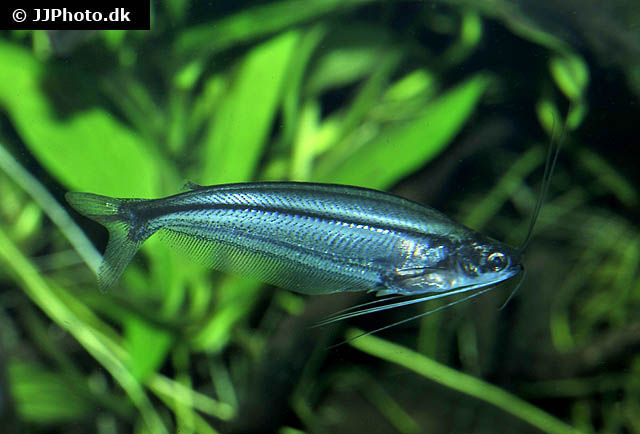| Schilbeidae (Schilbid catfishes) |
| 12 cm SL (male/unsexed) |
|
demersal; freshwater; pH range: 6.5 - 7.19999980926514; dH range: 5 - 15, potamodromous |
| Africa: Upper Nile to West Africa (Ref. 33556). In west Africa in the Chad basin, Niger, Senegal, Boubo, Bandama, Agnébi, Volta, Mono, Ouémé, Ogun, coastal lagoons of Nigeria and Cross (Ref. 57127). In lower Guinea limited to the Cross and Wouri Rivers (Ref. 81643). |
|
Dorsal spines (total): -0; Dorsal soft rays (total): -0; Anal spines: -0; Anal soft rays: 60-78; Vertebrae: 44-50. Diagnosis: dorsal fin absent; adipose fin always present; inner side of pectoral-fin spine variably denticulate, with small to rather well developed serrations; 60-78 soft rays in anal fin (Ref. 43912, 57127, 81643). Vomerine teeth present (Ref. 43912, 81643). In general no small dark blotch at the base of the caudal fin (Ref. 81643).
Description: pectoral spines more or less strongly developed (Ref. 81643). 44-50 non-fused vertebrae; gill rakers long; 9-11 branchiostegal rays on one side of head; caudal peduncle as deep as long or slightly deeper than long; important variation in degree of development of serrations on inner side of pectoral spine: individuals from a certain locality sometimes show poor and minute serrations, others from same locality showing more numerous, well developed serrations; lower jaw almost reaching as far as snout; head rounded, dorsum strongly curved; caudal peduncle very short; anal fin sometimes almost continuous with caudal fin; length of circumoral barbels rather variable from one population to another (Ref. 43912). In many respects this species resembles Parailia occidentalis and both species might even be considered as dubiously distinct or are at least very closely related; P. occidentalis can be distinguished from P. pellucida by the presence of a black triangular spot at the base of the anal fin in the former (which, however, also sometimes appears in specimens of P. pellucida), by the lower number of anal fin rays (51-68 in P. occidentalis against 60-78 in P. pellucida), lower number of non-fused vertebrae (41-45 in P. occidentalis versus 44-45 in P. pellucida) and by the fact that small vomerine teeth are present in P. pellucida while they are absent in P. occidentalis (at least in the specimens used for osteological preparations); moreover in examined specimens of P. occidentalis the inner side of the pectoral spine was always feebly to very feebly serrated, while these serrations are generally much better developed in P. pellucida (Ref. 43912).
Coloration: in life: body translucent, sometimes covered with small black dots (Ref. 43912, 57127, 81643). Skeleton and small swim-bladder clearly visible through the flesh (Ref. 43912). Preserved specimens: body pale whitish-beige, sometimes with small spots of pigment along lateral line, anal-fin base, head and back (Ref. 43912, 57127, 81643). Grey tail-stripe often present along median caudal fin rays (Ref. 43912). |
| Gregarious schooling species confined to larger lakes and rivers (Ref. 43912). Benthic species, occurs in deep water (Ref. 13851). Feeds mainly on small planktonic and benthic insects and crustaceans (Ref. 13851, 43912). Oviparous, eggs are unguarded (Ref. 205). Rarely exceeds 15 cm TL (Ref. 43912). Usually smoked or sun-dried, after which they are very tasty and may fetch high prices; sometimes ground into fish flour or fish meal and stored for long periods in sealed containers as an insurance against famine (Ref. 43912). |
|
Least Concern (LC); Date assessed: 09 June 2019 Ref. (130435)
|
| harmless |
Source and more info: www.fishbase.org. For personal, classroom, and other internal use only. Not for publication.

